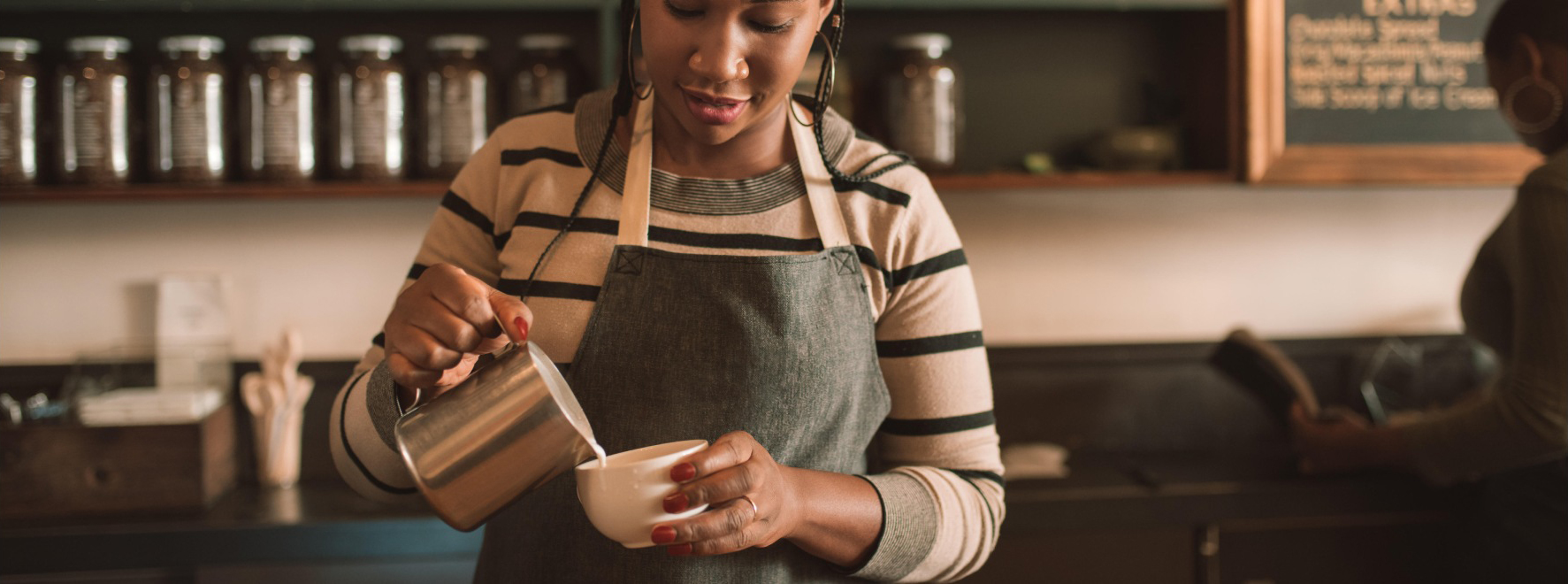The Tilt: Can the angle of the cup improve the quality of your coffee?
Anay Mridul speaks with several coffee experts to find out why baristas tilt their cups when pouring latte art and whether the same technique can improve extraction.
Walk into any pub worth its salt, and you’re likely to see bartenders pouring draught beer into carefully-tilted beer glasses.
In the world of barley and hops, this is typically done to achieve an optimal beer-to-head ratio, with the head referring to the thick layer of foam floating atop the golden brew.
On a more scientific level, tilting allows the bartender to manage the carbon dioxide that makes beer so satisfyingly bubbly. More specifically, tilting helps to release the CO2, ensuring that the head isn’t too thick.
Although coffee shops and pubs may seem worlds apart, a similar technique is used by baristas for two distinct purposes: to improve espresso brewing and to create aesthetically pleasing latte art.
However, while the latter is considered standard practice in cafés around the world, the jury is still out regarding the efficacy of tilting the cup during brewing. The founder of the Specialty Coffee Academy of India, Suhas Dwarkanath, is one proponent of this unconventional technique.
“Heavy solubles tend to settle at the bottom when the cup is placed straight,” he explains. “But when tilted, they tend to move and tumble around the espresso better in the cup, giving the person drinking the coffee a uniform experience throughout.”
More in the vein of the beer technique, founder of Batch Coffee Tom Saxon explains that holding the cup very close to the portafilter or spout during brewing and tilting it slightly will result in a larger and denser layer of crema.
This is particularly useful for coffees that produce a weak crema, and it’s widely accepted that crema creates a heavier, more balanced texture.
When it comes to latte art, tilting is less of a contentious topic. In this case, many coffee professionals consider it an essential aspect of creating latte art, which is considered a fundamental skill for the modern barista.
These days, latte art is a much-desired trait in espresso-based drinks like flat whites and cappuccinos. In fact, research shows that modern coffee consumers are willing to pay 11% more for a drink with latte art.

Does tilting the cup improve espresso extraction?
Marcus Wood is the co-founder of Sanctuary Coffee in London. He explains that when espresso is brewed, different compounds are extracted at different stages of the process.
“When the espresso lands in the cup, these acids and oils sit on top of each other due to a difference in mass,” he adds. “Some of these acids present higher bitter notes; some present higher sour notes.”
Rhian Nolan, Marcus’ co-founder, emphasises that tilting the cup doesn’t have any impact on improving extraction, arguing that extraction takes place entirely within the confines of the espresso machine.
Rather, she believes that it’s what happens after extraction that may warrant tilting the cup.
“Agitation of the espresso itself whilst in the cup does offer a better flavour experience,” she explains. “The various layers of coffee on a molecular scale are able to mix together, creating a beautiful harmony of flavours.”
There’s also an argument to be made for the shape of the coffee cup. Tom points out that while it doesn’t affect extraction, it can affect the espresso’s appearance and the depth of the crema.
Suhas, on the other hand, feels that cup shape plays an integral role.
“The bottom of the cup should always be curved or U-shaped to tumble the liquid around,” he says. “The mouth of the cup should not be too wide, or the crema will dissipate. Crema is very important as it holds and preserves the aromas inside the espresso, until the cup is brought near the lips and the first sip is consumed.”
Finally, he adds that the lip of the cup should be thick and rounded, as this “makes the consumer perceive the coffee to be rounded and creamy”.
Marcus agrees, arguing that the shape of the cup can affect how the human olfactory system interprets the coffee.
“A cup that’s domed towards our nose and mouth will generally direct the vapour towards us,” he notes. “As we inhale and sip our coffee, we will detect more of the coffee itself than we might have if the cup had a larger or less directed angle.”
Tilting as a tool for artistic expression
Rhian explains that lots of baristas tilt cups when pouring milk into espresso – more so than baristas who use tilting as a tool to improve extraction.
“The foamed milk will need a good amount of velocity to mix thoroughly with the espresso, allowing for a well-structured base for latte art to sit nicely upon,” he says.
Ultimately, it’s all about physics. Milk poured from a higher height sinks underneath the surface, while tilting allows the barista to create a larger surface area of espresso while shortening the distance between the top of the crema and the spout of the milk jug.
“As you pour, first break the surface of the espresso with the denser part of the milk,” Tom explains. “The cup will remain steady and tilted until you reach the part where the cup is around 70% full and the jug is predominantly more textured milk.”
The tilting doesn’t end there – he adds that as the barista begins to form the artwork, they should gently tilt the cup all the way back until they’ve finished the pour.
Suhas has an alternative view: “Tilting the cup doesn’t really affect latte art or the milk foam that’s poured on top,” he says.
Many baristas, he argues, forgo tilting and still manage to pour beautiful latte art. However, one thing all these experts agree on is cup rotation – both during extraction and while pouring milk.
“Baristas should definitely swirl the cup around to dissipate the crema for a latte or cappuccino, so that the milk, foam and espresso mix well together,” he continues. “It also helps with better contrast in the latte art designs.”
On that note, Tom explains that rotating the cup is only important when creating certain designs. For example, a rosetta or tulip doesn’t require the barista to rotate the cup while pouring. Nevertheless, when it comes to more complicated designs, he admits that the barista might need to “gently rotate the cup so they can add certain details”.
“Rotating doesn’t always mean easier,” Marcus adds. “It just gives an alternative perspective of the canvas and where you can apply beautifully steamed milk.”
Ultimately, while these nuances can be useful, a good cup of coffee always starts with high-quality beans and good equipment. And, tilting or not, baristas and prosumers require other fundamental skills to get the best out of their traditional espresso machines.








